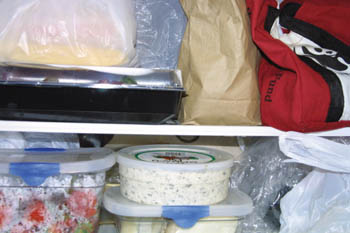![[Metroactive Dining]](/dining/gifs/dining468.gif)
[ Dining Index | Silicon Valley | Metroactive Home | Archives ]

Photograph by Traci Vogel These Lids Are Sealed: A refrigerator well stocked with Tupperware holds just as much value these days as a safety deposit box. The New Economy Take another look at leftovers--the second glance might just save you a mint (and we're not talking dinner mint) By Sharon Mizota ONCE UPON a time (read: "dotcom boom"), leftovers were casually disposable. If I didn't want to lug a greasy doggy bag around after dinner, who would blame me for leaving a few bites of pork chop on my plate? At home, I congratulated myself for cooking enough food to last a week, but come an unexpected dinner date, it was no big deal if lasagna grew moldy. Leftovers were like a subterranean bonus level in Super Mario Brothers. They added to your score, but they didn't guarantee you'd rescue the princess. In leaner times, what once looked like garbage now looks like lunch. I recently reheated Friday's Vietnamese noodles for the fourth (and, thankfully, final) time, and last week, in a moment of gastronomic ingenuity, I used the remnants of a red snapper fillet to enhance a too-bland onion soup. No longer just for reheating, leftovers can be recombined and transmuted in ever-engrossing patterns to prolong their nutritive (or at least belly-filling) value. But although my concoctions may taste as good as fresher fare, the fact that I must eat them day after day is no substitute for the whimsy of free-wheeling days gone by. There's no way around it: economic necessity has taken some of the zest out of eating. The enticement of fresh food has been replaced by the practical comfort of a well-stocked fridge: fullness trumps flavor. I worship at the altar of Ziploc and Rubbermaid. This cult of fullness over tastiness has its lifelong devotees--chief among them, my mother. My parents once dined at the illustrious French Laundry, and my mother's only memory of the meal is that she was still hungry afterward. Her criterion for a good meal is not "Does it taste good?" but "Am I full yet?" Fullness must be carefully guarded and maintained, and leftovers are an integral part of that endeavor. Caught between the rock of thrift and the hard place of hunger, my mother consumes anything this side of putrefaction. She'll save half a cup of rice and reheat it for breakfast with some chicken-tortilla casserole and graying broccoli. Nothing remotely edible can ever, in good conscience, be thrown away. My mother comes from a working-class family that often struggled to keep food on the table. I remember a lunch of cold noodles at my grandparents' house that arrived at table studded with tiny dead black bugs. My sister and I wouldn't touch them, but my grandfather calmly picked out the bugs and proceeded to eat, completely unperturbed. I see him now in my mother as the last bit of salad or piece of meat disappears quietly and uncomplainingly into her mouth. This compunction cannot be completely joyless; fullness possesses a sleepy pleasure all its own, and there is no denying the satisfaction found at the dizzying heights of thriftdom. But perhaps there is another pleasure buried therein. My mother is a pack rat. She enjoys combing flea markets for antiquated objects that show the marks of use and time. Her compulsive relationship to leftovers is more than economy and fullness; it's a simple appreciation of the passage of time. After all, some foods are actually better as leftovers. There's nothing more pleasurably guilt inducing than a slice of cold pizza in the morning. (I feel my arteries hardening like so much congealed cheese with every bite, but I keep eating.) Chili, meatloaf, spaghetti sauce and soup all improve in flavor and richness with a little sleepover chez fridge. Flavors mellow, intermingle, become more distinct, or sometimes, softer. Some things are better experienced over the distance of a little time, and I suppose my newfound embrace of leftovers is a way of coming to terms with time's passing. In his book, The Soul of a Chef: The Journey Toward Perfection, Michael Ruhlman attributes food's mysterious power to the life cycle. Put plainly, food is evidence that living things die in order to sustain life, encapsulating the terms of our very existence. If just-shucked oysters are life itself, pulsing and shimmering on a plate, then leftovers, devolving gracefully in the back of your fridge, are that same life, on its way back around. Enjoy them with the knowledge that you're part of life's grand recycling scheme.
Send a letter to the editor about this story to letters@metronews.com. [ Silicon Valley | Metroactive Home | Archives ]
|
From the July 24-30, 2003 issue of Metro, Silicon Valley's Weekly Newspaper.
Copyright © Metro Publishing Inc. Metroactive is affiliated with the Boulevards Network.
For more information about the San Jose/Silicon Valley area, visit sanjose.com.